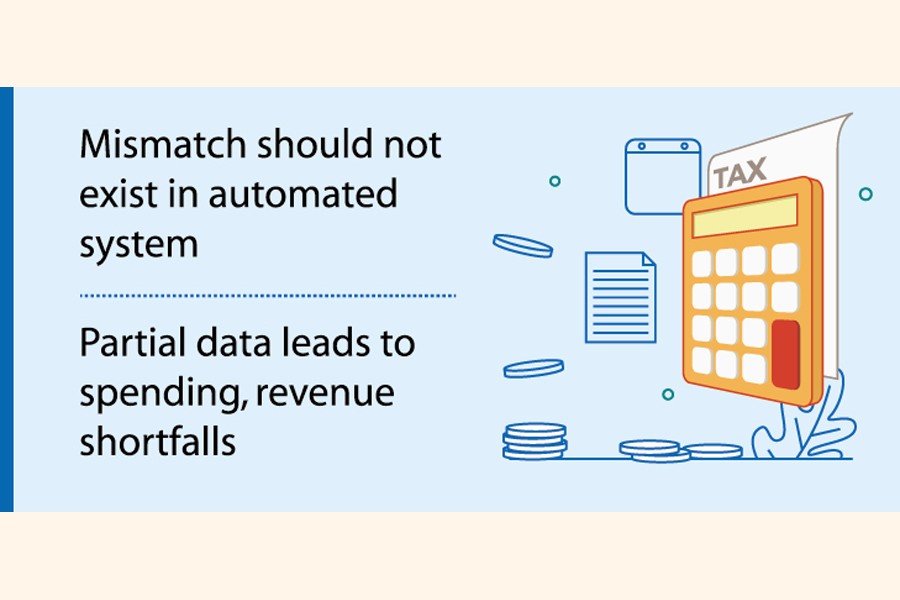
Two divisions under the Ministry of Finance (MoF) have revealed opposite pictures on tax-revenue-collection data of the first half (H1) of the current fiscal year (FY), 2022-23, creating confusion over the country's major income sources.
Tax revenue collection data is one of the major indicators of the economy, through which the government sets its expenditure and borrowing targets.
The MoF's two wings - the Finance Division (FD) and the Internal Resources Division (IRD) - disclosed contradictory data in recent times.
Analysing data of the FD and the National Board of Revenue (NBR), the FE correspondent found major mismatch, which, according to officials, should not exist after introduction of the automated public finance system.
According to the MoF data, the NBR's tax collection posted 4.0 per cent negative growth in the H1 of FY 23.
While, according to the NBR's compiled data, the tax collection grew by 11 per cent in the same period of the current FY.
Towfiqul Islam Khan, Senior Research Fellow of the Centre for Policy Dialogue (CPD), said these contradictions undermine accountability and transparency in formulation of the budgetary policy.
Furthermore, Bangladesh's Public Financial Management (PFM) Action Plan 2018-2023 rightly noted that incomplete data makes macro-modelling less reliable, leading to spending and revenue shortfalls - compared to the budgetary targets.
He also said differences in data collection methods and sources, variations in indicator definitions, and variations in reporting time lag are potential causes of data disagreement.
"Confusion may result from these differences while making policy decisions. Stakeholders frequently forego accuracy and credibility of data in favour of what is more easily accessible," he added.
According to the NBR data, tax revenue collection was Tk 1.45 trillion in the July-December period of FY 23 against Tk 1.31 billion in the same period of the previous FY.
The MoF data, however, said the NBR's actual tax collection was Tk 1.41 trillion in the first six months of the current fiscal, which was Tk 1.46 trillion in H1 of last FY.
Talking to the FE, a senior official of the NBR said the FD reported higher tax revenue collection data last year, which took the growth rate into negative territory.
"We collect data from the field-level offices across the country and compile."
He also said they collect data through the Integrated Budget and Accounting System (iBAS++) system, connected with the government's AG Office, where actual taxes are deposited.
The mismatch could be resolved through reconciliation of the NBR data with the FD, he added.
Earlier, the NBR formed a reconciliation committee, comprising officials of the FD, Comptroller and Auditor General (CAG) office and NBR, which did not work properly.
The FD data said collection of income tax, import tax and value added tax (VAT) was Tk 441.92 billion, Tk 397.60 billion and Tk 570.52 billion respectively in the July-December period of FY 23.
The NBR data quoted Tk 4.50 billion and Tk 51.90 billion higher income tax and import tax collection respectively.
However, the FD's VAT collection data was higher than that of the NBR's compiled one.
Mismatch was also found in the NBR's last FY data, where the NBR disclosed above Tk 3.0 trillion publicly as provisional data, while the FD reported Tk 2.87 trillion against its target for Tk 3.30 trillion.
The FD officials said such mismatch in tax revenue collection data had been reported for a long period, and such opposite pictures raised concerns among the stakeholders.
The senior FD officials are aware of the contradictory tax revenue growth calculation with the NBR, they added.
The NBR official said the board-released data is usually made public as 'provisional', which may vary after compiling final data by the FD, as it uses iBAS++.
The CPD senior research fellow said, "The MoF's iBAS++ is built on an accounting process. Therefore, there is little room for duplicate counting or false reporting."
"As a result, the information provided by this system ought to be more precise. Public finance data quality can be improved, if iBAS++ data is made more broadly and promptly available."
A joint working group, comprising the NBR, CAG and MoF officials, should be formed to resolve the issue. Such attempts, made in the past, should be continued. The MoF report should be released within the next month, so that the stakeholders, including the policymakers, can use the IBAS++ data regularly, he added.
© 2024 - All Rights with The Financial Express
